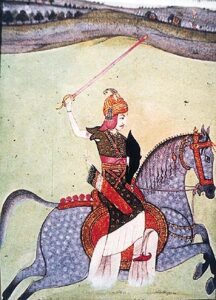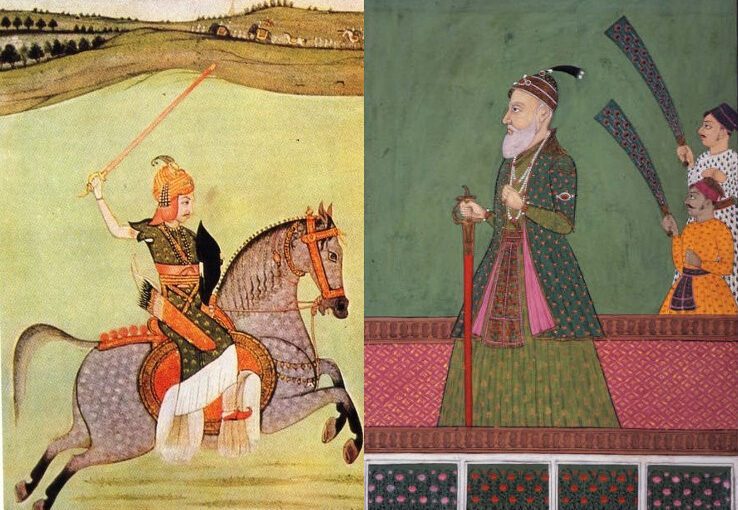Content
Peshwa Baji Rao
This great military general of the Maratha Empire was born on 18 August 1700. He is remembered for expanding the Maratha Empire. During the military career of Peshwa Baji Rao which was 20 years long, the Maratha Empire reached its zenith and crushed every single Sultanate or empire which stood in his way. For his invincibility, he is highly respected in Maharashtra and consequently in India.
Note: Baji Rao was the 7th Peshwa.

The Hero of the Battle of Palkhed
He was the son of former Peshwa Balaji Vishwanath and his wife Radhabai Barve. He later served as Peshwa to the fifth Maratha Chhatrapati (Emperor) Shahu from 17 April 1720, until his death.
Baji Rao (Baji Rao 1) was the ablest of all the Peshwa who had developed his interest in military affairs at an early age. He was the first one who identified the Mughal Empire’s weakness when he visited Delhi in 1719. During this visit, the young opportunist immediately realized that the Marathas now had to be prepared for Swaraj.
Note: Initially Peshwa Baji Rao spent most of his time observing the political situation at Deccan and in Delhi. After the battle of Palkhed Baji Rao shifted his attention towards Delhi, Malwa, Bundelkhand, and even against Portuguese.
But as happened to many of our great kings they had been sidelined from our history textbooks same had happened to Peshwa Baji Rao.
Background:
The expedition of the sixth Mughal Emperor i.e. Aurangzeb on Deccan and against the Marathas didn’t go well. The vast amount of wealth and resources were drained into these campaigns which heavily cost them in the future.
After the death of Aurangzeb, there was a struggle for the throne of Delhi and later Farruksiyar (1713-1713) became the ruler of the Mughal Empire. Several governors of the Mughals declare independence from them. At this critical juncture, the Sayyed brothers rose to the power.
There were a total of 6 provinces at Deccan namely Khandesh, Berar, Aurangabad, Bidar, Bijapur, and Hyderabad. The Sayyid brother acknowledges the rule of Shahu and granted the latter to collect taxes from the above-mentioned six provinces of Deccan.
During the reign of Farruksiyar the Sikhs were also heavily persecuted.
Rise of Nizam ul Mulk
Originally Nizam ul Mulk was known as Mir Qamar ud din. Born in the year 1671 and from an early age, he witnessed the rise of the Maratha Empire, took part in various battles at Deccan. He soon began a renowned name in Deccan and due to his several military success in the year 1699, he was known as Chin Qilich Khan.
The power of Nizam can be appreciated from the fact that Aurangzeb told him that his son Kam Baksh should become the next emperor with his help.
In the year 1720, the Nizam was appointed as the Vazir of the Mughal Empire. Nizam’s relation with the Mughals also bitter and he realized that soon or later this empire will crumble. Due to this after a series of political chaos Nizam founded an independent dynasty at Hyderabad. He was fully aware of the Maratha threat and after becoming Nizam he refused to give the taxes to the Marathas.

The Mughal Governor of Deccan
At this time the Marathas were witnessing a civil war. Between Shahu of Satara and Shambhaji of Kohlapur. Nizam decided to use this as the divide and rule tactics and allied with Shambhaji, Rao Chandrasen Jadhav, and some other Maratha chief against Shahu and Baji Rao. This move from the Nizam made Shahu vulnerable, and he recalled his army from the south to counter this move.
The Peshwa Baji Rao arrived with his army and on 1 August 1727, the order to invade the territories of Nizam was passed. It was decided that after the end of the monsoon season the Peshwa’s army which was mainly composed of light cavalry will invade Aurangabad the stronghold of Nizam.
Battle of Palkhed
According to Field Marshal Montgomery, the battle of Palkhed was a masterpiece of strategic mobility. Baji Rao’s army didn’t have any artillery support and had only lancers and light cavalry. The Maratha army had a spare horse for every two men and was free from any load which could affect their mobility.
Furthermore, the Marathas continuously changed their movement due to this the pursuing army of Nizam which had heavy artillery, baggage, and other stuff couldn’t give up the chase. They mainly focused on raiding and looting the capturing cities.
Let us transcend the barren Deccan and conquer central India. The Mughals had become weak indolent womanizers and opium addicts. Strike, strike at the trunk, and the branches will fell off themselves. Listen but to my counsel and I shall plant the Saffron Flag on the walls of Attock
Peshwa Baji Rao
Nizam was carrying camp followers and tents which further made his army vulnerable.
Note: Peshwa Baji Rao’s army was fully mounted.
The Palkhed Campaign of 1728 is notable for two reasons. First, this campaign has been chosen as brilliant in strategy secondly the success of this campaign established the Maratha Supremacy.

Note: The Nizam pursued Baji Rao’s army around the vicinity of Pune for about six months where Baji Rao executed hit and run tactics to finally corner the Nizam at Palkad.
Nizam ul Mulk’s army pursued Baji Rao. Baji Rao then moved westward to Gujarat from North Khandesh. However, Nizam gave up the pursuit and moved southward towards Pune.
In the month of November a skirmish occurs between Baji Rao and Iwaz Khan at Jalna but the Maratha general i.e. Baji Rao decided not to engage themselves in an open battle against the Nizam forces. Due to this the Maratha then marched toward northern Khandesh and then to Gujarat while the Nizam’s forces chasing them.
Nizam couldn’t match the pace of the Maratha cavalry and decided to give the chase and left the pursuit of Baji Rao and moved towards the headquarters of the Shahu’s stronghold, posts like Udapur, Avasari, Pabal, Khed, and Narayangarh surrendered to Nizam who then occupied Pune and advanced towards Supa, Patas and Baramati.
Note: These captured cities were looted and plundered ruthlessly by the Nizam forces.
Shahu appealed to Baji Rao to come back in order to defend the city of Pune. Despite this Baji Rao decided to subjugate Aurangabad the capital of Nizam. The Peshwa ransack every single village and district of Nizam territory and reached Gandhapur and Baizapur.
In Baramati Nizam got news of Baji Rao moving towards Aurangabad through Kasarbari pass. Nizam began moving northwards to intercept the Maratha army. By this time he was confident of crushing Baji Rao and his army. It was not to happen so. The raja of Kolhapur Sambhaji refused to join him in this campaign against Baji Rao.
Nizam and his army were surrounded in a waterless tract near Palkhed on 25 Feb 1728. His army was completely exhausted and their morale went down. For six days the flanks of Nizam’s army were harassed by sudden attacks of the Marathas. To make the situation even grimmer Peshwa Baji Rao blocked all the possibility of the Nizam army to get any provisions.
The Nizam was defeated by the Marathas and signed a treaty on March 6, 1728. By the treaty of Muji Shivagaon, the Nizam was forced to make certain concessions. Chhatrapati Shahu was recognized as the only Maratha ruler. Marathas were given the right to collect Chauth and Sardeshmukhi of Deccan. Those revenue collectors driven out would be reappointed. The balanced revenue was to be paid to Chhatrapati Shahu.
The battle of Palkhed gave one of the best military generals of India and the Maratha Empire. After the battle increased the prestige of Peshwa Baji Rao. Sir Jadunath Sarkar an eminent historian described Baji Rao as Carly lean Hero as a man of action.
LIKE WHAT WE ARE DOING? DONATE TO DHARMAYUDH
If you Support what we are doing and would like to contribute to help us grow and reach more Indians to teach them more about such forgotten historic Indian Heroes and stories, please consider donating any amount. It will help us grow.

